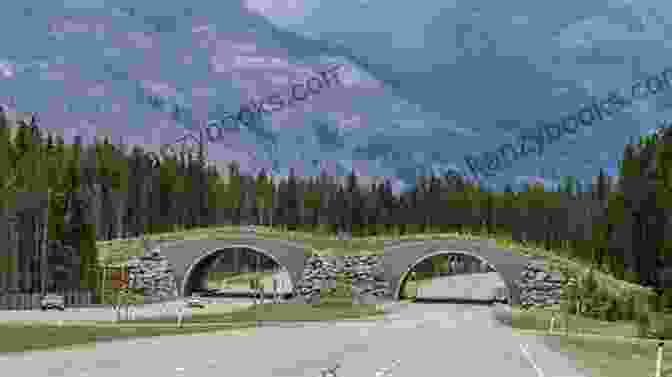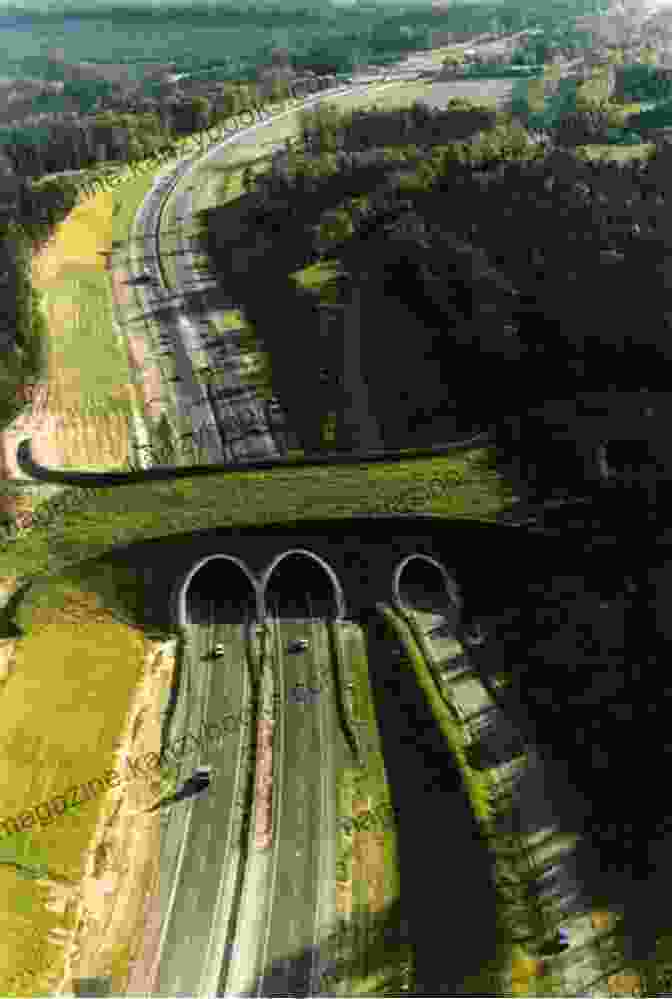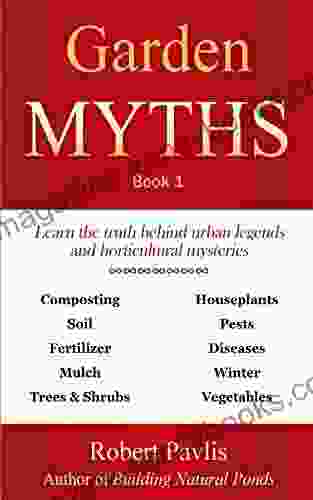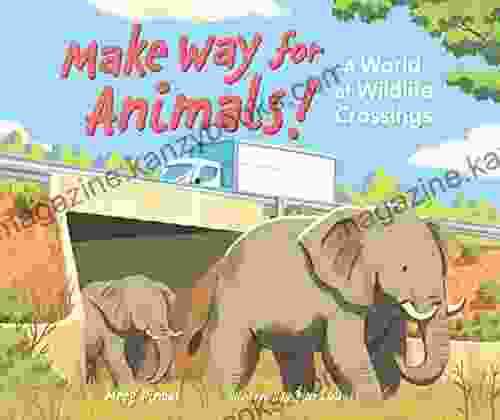Wildlife Crossings: Bridging the Gap Between Nature and Infrastructure

As the human population continues to grow and expand, so too does our impact on the environment. One of the most pressing issues facing wildlife today is habitat fragmentation, which occurs when natural habitats are broken up into smaller and smaller pieces, often by roads, railways, and other infrastructure. Fragmentation can have a devastating impact on wildlife, making it difficult for animals to move around, find food, and reproduce.
One solution to the problem of habitat fragmentation is the construction of wildlife crossings. Wildlife crossings are structures that allow animals to safely cross over or under roads and other barriers. These crossings can take a variety of forms, including bridges, tunnels, and culverts.
4.6 out of 5
| Language | : | English |
| File size | : | 7792 KB |
| Screen Reader | : | Supported |
| Print length | : | 126 pages |
The benefits of wildlife crossings are numerous. Crossings can help to reduce animal-vehicle collisions, which can kill or injure animals and damage vehicles. They can also help to improve water quality by reducing the amount of sediment that enters waterways from roads. In addition, crossings can provide opportunities for recreation and education, and they can help to connect isolated populations of animals.
One of the most successful examples of a wildlife crossing is the Banff Wildlife Crossings project in Banff National Park, Canada. The project, which was completed in 2013, has resulted in a significant reduction in animal-vehicle collisions and has had a positive impact on wildlife populations in the area.
The Banff Wildlife Crossings project is just one example of the many ways that we can help to mitigate the impacts of habitat fragmentation on wildlife. By building more wildlife crossings, we can help to ensure that wildlife has the opportunity to move around freely and find the resources they need to survive.
Types of Wildlife Crossings
There are a variety of different types of wildlife crossings, each of which has its own advantages and disadvantages. The most common types of crossings include:
- Bridges: Bridges are elevated structures that allow animals to cross over roads and other barriers. They are typically used for larger animals, such as deer, elk, and moose.
- Tunnels: Tunnels are underground structures that allow animals to cross under roads and other barriers. They are typically used for smaller animals, such as rabbits, squirrels, and reptiles.
- Culverts: Culverts are large pipes that are installed under roads and other barriers. They allow animals to cross through the pipes, which are often filled with water or debris.
The type of wildlife crossing that is best for a particular location will depend on a number of factors, including the size of the animals that need to cross, the volume of traffic on the road, and the cost of construction.
Benefits of Wildlife Crossings
Wildlife crossings provide a number of benefits, including:
- Reduced animal-vehicle collisions: Wildlife crossings can help to reduce the number of animal-vehicle collisions, which can kill or injure animals and damage vehicles. Crossings can also help to reduce the risk of human injuries or fatalities from animal-vehicle collisions.
- Improved water quality: Wildlife crossings can help to improve water quality by reducing the amount of sediment that enters waterways from roads. Sediment can clog waterways, making them less habitable for fish and other aquatic life.
- Increased connectivity: Wildlife crossings can help to connect isolated populations of animals, which can improve their chances of survival. Crossings can also allow animals to access new areas for food, water, and shelter.
- Recreation and education: Wildlife crossings can provide opportunities for recreation and education. Crossings can be used for hiking, biking, and wildlife viewing. They can also be used for educational purposes, such as teaching children about the importance of wildlife conservation.
Challenges to Wildlife Crossings
Despite the many benefits of wildlife crossings, there are also a number of challenges to their construction and maintenance. Some of the most common challenges include:
- Cost: Wildlife crossings can be expensive to construct and maintain. The cost of a crossing will vary depending on the type of crossing, the size of the crossing, and the location of the crossing.
- Effectiveness: Wildlife crossings are not always effective in reducing animal-vehicle collisions or improving water quality. The effectiveness of a crossing will depend on a number of factors, including the location of the crossing, the type of crossing, and the size of the animals that need to cross.
- Public opposition: Some people oppose the construction of wildlife crossings, often due to concerns about cost, effectiveness, or safety. Public opposition can make it difficult to build wildlife crossings, even in areas where they are needed.
Wildlife crossings are an important tool for mitigating the impacts of habitat fragmentation on wildlife. Crossings can help to reduce animal-vehicle collisions, improve water quality, increase connectivity, and provide opportunities for recreation and education. However, there are also a number of challenges to the construction and maintenance of wildlife crossings. These challenges include cost, effectiveness, and public opposition. Despite these challenges, wildlife crossings remain an important option for protecting wildlife and improving our environment.
World of Wildlife Crossings is a comprehensive resource for information about wildlife crossings. The website includes information on the different types of wildlife crossings, the benefits of crossings, and the challenges to their construction and maintenance. The website also includes a map of wildlife crossings around the world.



4.6 out of 5
| Language | : | English |
| File size | : | 7792 KB |
| Screen Reader | : | Supported |
| Print length | : | 126 pages |
Do you want to contribute by writing guest posts on this blog?
Please contact us and send us a resume of previous articles that you have written.
 Book
Book Novel
Novel Page
Page Chapter
Chapter Text
Text Story
Story Genre
Genre Reader
Reader Library
Library Paperback
Paperback E-book
E-book Magazine
Magazine Newspaper
Newspaper Paragraph
Paragraph Sentence
Sentence Bookmark
Bookmark Shelf
Shelf Glossary
Glossary Bibliography
Bibliography Foreword
Foreword Preface
Preface Synopsis
Synopsis Annotation
Annotation Footnote
Footnote Manuscript
Manuscript Scroll
Scroll Codex
Codex Tome
Tome Bestseller
Bestseller Classics
Classics Library card
Library card Narrative
Narrative Biography
Biography Autobiography
Autobiography Memoir
Memoir Reference
Reference Encyclopedia
Encyclopedia Lara Casey
Lara Casey Ken Fisher
Ken Fisher Margery Phelps
Margery Phelps Kij Johnson
Kij Johnson Mia Munro
Mia Munro Ken Wilber
Ken Wilber Kenneth Thomasma
Kenneth Thomasma Teri Pichot
Teri Pichot Tracy Dwyer
Tracy Dwyer Nauman Rasool
Nauman Rasool Kristen Mancinelli
Kristen Mancinelli Monica Harris
Monica Harris Phani Raj
Phani Raj Lora Cipriano
Lora Cipriano Kimberly S Young
Kimberly S Young Kevin L Michel
Kevin L Michel Kenneth Choi
Kenneth Choi Kifah Dasuki
Kifah Dasuki Viveka Von Rosen
Viveka Von Rosen Laura Anne Lapp
Laura Anne Lapp
Light bulbAdvertise smarter! Our strategic ad space ensures maximum exposure. Reserve your spot today!

 Nikolai GogolSimple Guide to Williams Syndrome: Happy Elf Syndrome Diagnosis, Treatment,...
Nikolai GogolSimple Guide to Williams Syndrome: Happy Elf Syndrome Diagnosis, Treatment,...
 Harold PowellYour Ultimate Guide to Adrenal Glands: Functions, Diseases, Diagnosis, and...
Harold PowellYour Ultimate Guide to Adrenal Glands: Functions, Diseases, Diagnosis, and... Trevor BellFollow ·8k
Trevor BellFollow ·8k Cody RussellFollow ·3.8k
Cody RussellFollow ·3.8k Jeff FosterFollow ·18.2k
Jeff FosterFollow ·18.2k Jules VerneFollow ·19.6k
Jules VerneFollow ·19.6k Victor TurnerFollow ·15.8k
Victor TurnerFollow ·15.8k Rod WardFollow ·4.4k
Rod WardFollow ·4.4k Houston PowellFollow ·9.2k
Houston PowellFollow ·9.2k Grant HayesFollow ·3k
Grant HayesFollow ·3k

 Ernesto Sabato
Ernesto SabatoLoving Table: Creating Memorable Gatherings
Gatherings...

 Mark Twain
Mark TwainLifestyle After Cancer: The Facts
Cancer is a life-changing...

 Keith Cox
Keith CoxUnlocking the Nutritional Needs of Individuals with...
Individuals with physical disabilities...

 Rubén Darío
Rubén DaríoHandbook And Guide To Evaluation And Treatment
Empowering Healthcare...

 Andy Hayes
Andy HayesUnveiling the Truth: "Garden Myths" by Robert Pavlis...
The world of gardening is often filled with a...
4.6 out of 5
| Language | : | English |
| File size | : | 7792 KB |
| Screen Reader | : | Supported |
| Print length | : | 126 pages |










